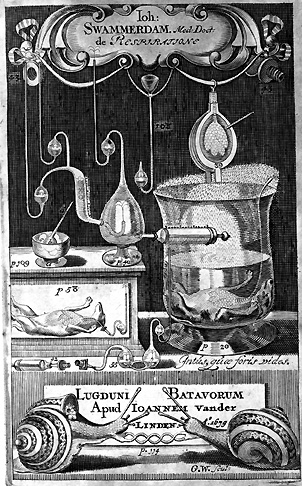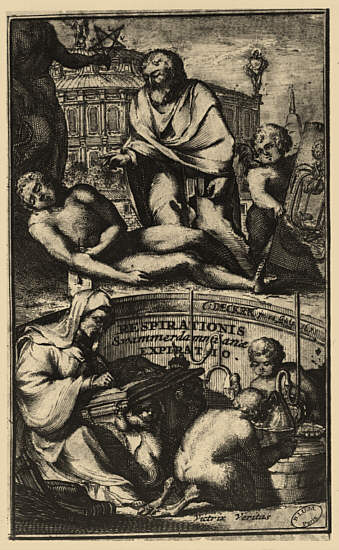 |
|
and their meaning |
| Swammerdam’s science His life and work Nerve function Muscles Bees and ants "The Bible of Nature" Amazing drawings Techniques and microscopy Preformationism Swammerdam’s life Birth Death A fake “portrait” Science in society Empiricism and religion Mysticism and modern science Illustrations and their meaning Swammerdam in culture Swammerdam's world Friends and contemporaries Contemporary accounts On-line resources Under construction: Discussions of Swammerdam’s work A bibliography of Swammerdam's works Contact |
1. The frontispiece of Swammerdam's doctoral thesis, "De Respiratione" (1667). For commentary, see below.  This bizarre, highly detailed engraving is in fact a summary of the contents of "De Respiratione": besides each piece of apparatus is the page number where the appropriate experiment is described. In several cases, the frontispiece provides additional information as to how the apparatus was employed: for example, the thermometer for measuring the temperature of the blood after its passage through the lungs is shown in use, next to the vivisected dog on the left (“p58”), the experiment with the dog under water is also clearly shown (“p20”), the dotted material around the end of the tube portraying the movement of air, and the glass sided bellows are illustrated hanging from the title, complete with a pair of (badly drawn) lungs inside (“39”). However, the part of the frontispiece that most strikes the eye, and which was the most important premonition of Swammerdam’s future, is the portrayal of the snails at the bottom. This illustration, which is a mixture of the accurate and the fantastic, has little to do with respiration (although the breathing-pore is clearly shown on the snail on the left, at the entrance to the shell). The key point is that they are copulating in a reciprocal manner: this refers to Swammerdam’s brief announcement (in Part 3, Chapter IV) that he has discovered that snails are hermaphrodite. The intertwined structures are in fact the penes of the two snails, although in reality snail copulation is never as tidy as this and usually involves the copulating pair being much closer. 2. A polemic against Swammerdam's "De Respiratione".  In 1674, a Dutch doctor, Jan Baptist van Lamzweerde, published a long polemical attack on De Respiratione, under the punning title Respirationis Swammerdammianae Exspiratio (“The expiration of Swammerdam’s De Respiratione”). Lamzweerde, a convinced Aristotelian for whom any attempt to develop knowledge had to be resisted, sought to denounce what he considered to be “the author’s crass errors”. The frontispiece shows what Lamzweerde thought he was doing: Truth (apparently in the shape of Aristotle) triumphs over a cloven-hoofed devil who is playing with one of Swammerdam’s pieces of apparatus. Inside, Lamzweerde used argument, rather than experimentation, to convince the reader that Swammerdam’s model of respiration simply would not work. This illustration was taken from here. |